Back home in Florida, we were treated to a very colorful sky about 7 minutes after sunrise on November 23. The sun had just touched the opposite shore. This is straight out of the camera. The image is not cropped or processed:
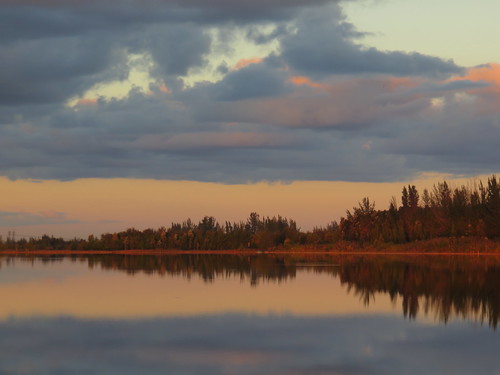
Ruby-throated Hummingbird hovering over Firebush (Hamelia patens):

Eastern Phoebe perching on a guard rail:
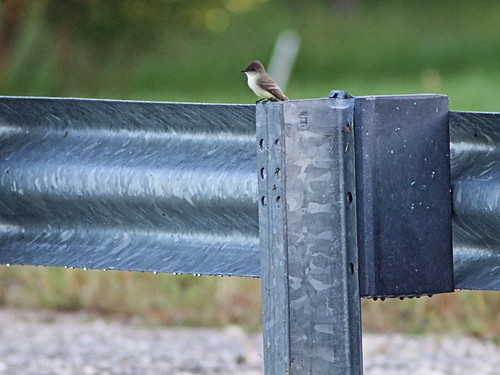
I enjoy the challenge of photographing LBBs (little brown birds), the smallest of which are the wrens. Seeing them requires patience and often long periods of watchful waiting.
I first sighted a Marsh Wren in Troy Meadows, New Jersey as a teenager back in May of 1949, when I participated in a "Big Day" with the Hackensack Audubon Society. It was then called "Long-billed Marsh Wren" to distinguish it from the diminutive prairie-dwelling "Short-billed Marsh Wren," which since 1982 has been known as the Sedge Wren. I would not see the latter species until November, 1951 when, at Moriches Bay and Inlet in Long Island, I joined a group of birders from Long Island, New York, led energetically by Allan Cruickshank. (He passed away in 1974. Here is his obituary in American Birds).
Group outings can produce large numbers of sightings. For a relatively new birder this can be quite overwhelming. The single day at Troy Meadows and environs yielded 23 new birds species to my life list, and the trip to Long Island added 15 species. I must admit that I do not have indelible memories of either of these wren sightings. Although the trips and places are still relatively fresh in my mind, some of the individual birds seem now to have been lost in the sea of discoveries.
My more recent encounters with these species have been at a more personal level. Finding them took individual effort. With only two eyes to look for them instead of scores, and delightful long looks to enjoy not only their plumage and anatomical features as well as their habits, habitats and vocalizations, the experience is more meaningful and memorable.
This is my Marsh Wren "sit spot" in our local birding patch. It is conveniently situated near the lake next to a Pond Cypress. A young Pond Apple tree is visible to the left and the "Pine Bank" (a dense stand of Australian Pine) is in the distance across the lake. Two large clumps of Sawgrass are directly in front, and a large area of cattails, just to the right, extends out to the shoreline:
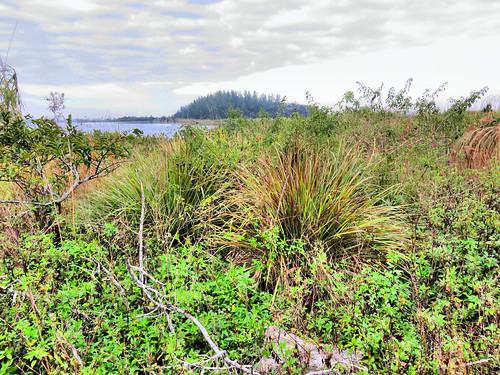
While waiting for the wren, other wetland-associated birds may pop up, such as this Swamp Sparrow:
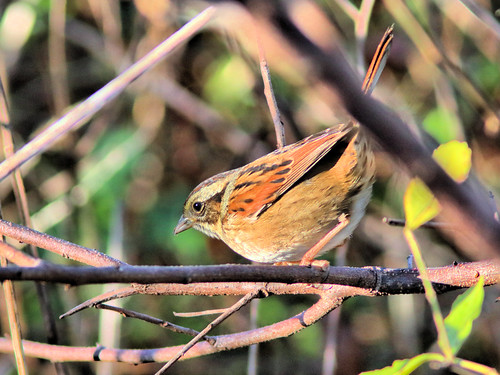
It climbs a reed to get a better look at me..
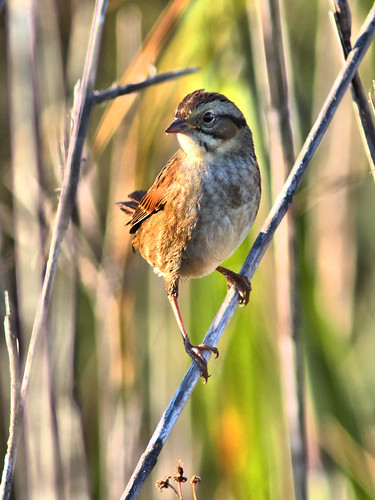
...and quickly exits:
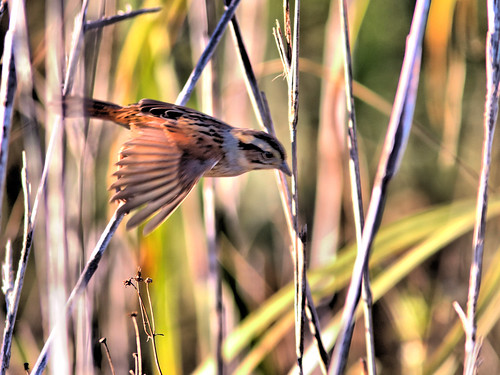
In Illinois, I often caught snippets of the Marsh Wren's song or saw one weave in and out of the cattails in the distance. After taking up bird photography about 8 years ago I set a goal of capturing an image of every bird species I saw.
My first close encounter with a Marsh Wren with camera at the ready occurred in September, 2014 in a cattail marsh in Geneva, Illinois. My photos aptly illustrate the connection between this species and its preferred habitat:

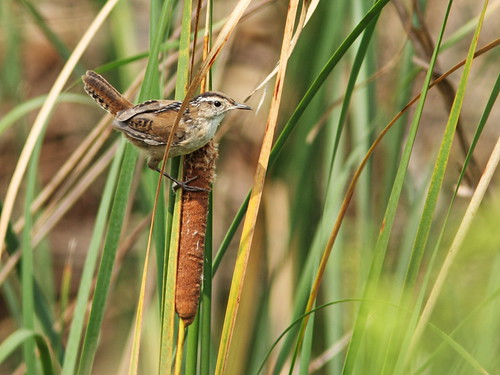

This week I added the 169th species to the bird list for my neighborhood birding patch. Of these I have seen 162, and a few of the species reported by other observers are a bit suspect. This is the first photo of my local Marsh Wren (November 18, 2016):
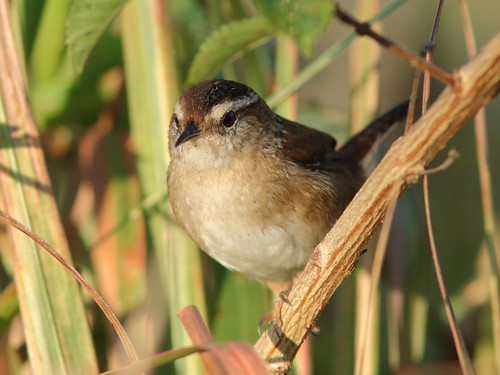
I obtained better views the next day:
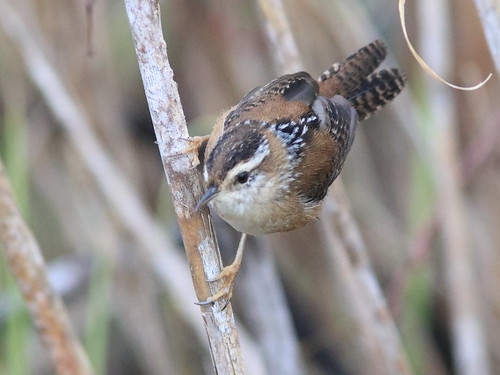
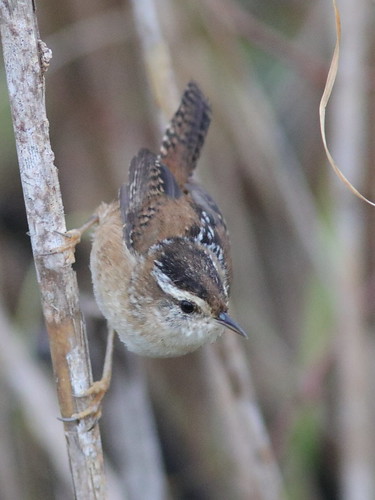
The Sedge Wren (11 cm long) is a half inch shorter than the Marsh Wren, which is 5 inches (13 cm) long. While I have seen a wintering Sedge Wren in Florida, it is a fairly common breeder near our second home in Illinois. It is usually found on dry ground such as a prairie, often next to or within sight of water.
Very elusive, this little creature will not sit still for a photo. Here are a few of my favorite Sedge Wren portraits, all from Nelson Lake in Kane County, Illinois:
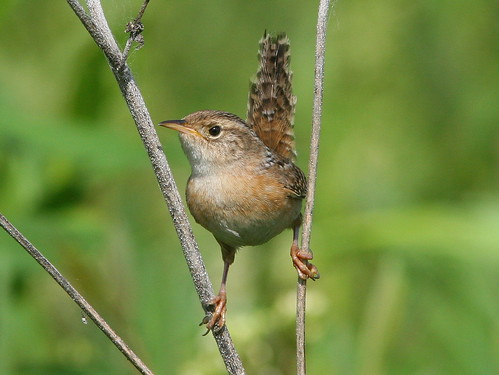


My latest image is a favorite as it best illustrates the wren's imitation of an Olympic parallel bar gymnast (Oct 18, 2016):
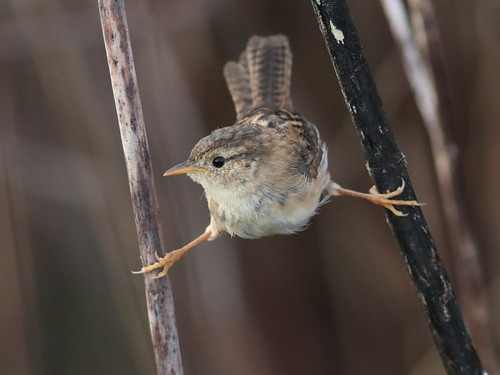
Happy Thanksgiving, everyone in the USA (and belated good wishes to our Canadian friends). I do not have a good turkey photo, but this week a Turkey Vulture obliged me by finding a dead squirrel on the sidewalk in front of our next door neighbor's home. I guess this bird was named because of its strong (?) resemblance to the real thing. (Click on the photo to navigate to some more rather explicit images of his feast):

The entrance to our humble birding patch is defined by a gate and chain-link fence. Royal Palms line both sides of the gravel road which leads to a wet prairies, woodlands and a lake:
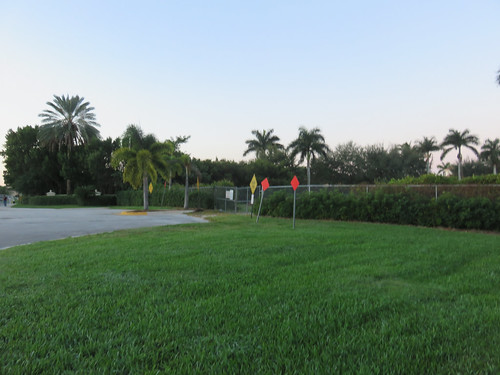
This is the view looking back down the road before sunrise:

View of the lake on a murky morning this week, just before sunrise:
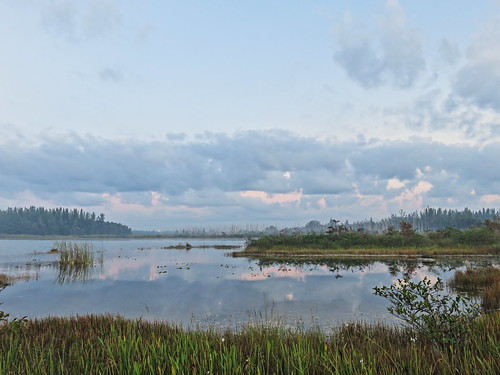
This past year our Homeowners Association planted hedges of Firebush (Hamelia patens), a most welcome innovation. Their blooms attract wintering hummingbirds and also butterflies such as this Zebra heliconian:
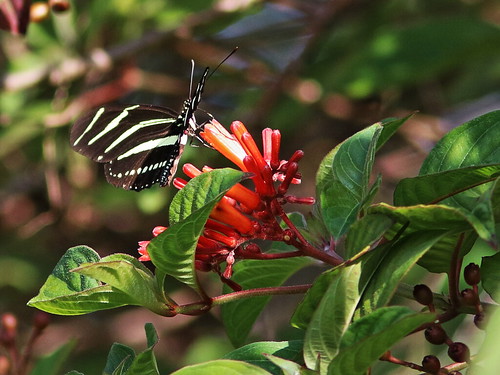
A roosting Red-shouldered Hawk strikes a characteristic pose. It appears to be deep in thought, with head gently bowed, chin to chest. Its mind must be so far off, meditating, contemplating its place in the order of nature? Might I startle it into awareness by touching its red shoulder?
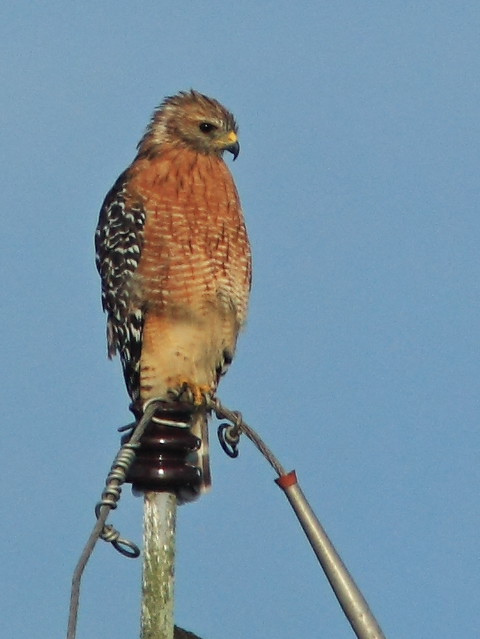
Of course, this is far from the truth. The hawk is keenly aware of the surroundings. Sharp eyes are actually watching for any scant movement which might betray the presence of a prey item, whether insect, reptile, amphibian, small mammal or bird. Immobility and stealth are essential assets for a successful hunt.
Adult Red-shouldered Hawks vary from very colorful (as above) to rather pale. Those native to Florida tend to have a sun-bleached appearance, due to genetic variation rather than the effects of UV rays:
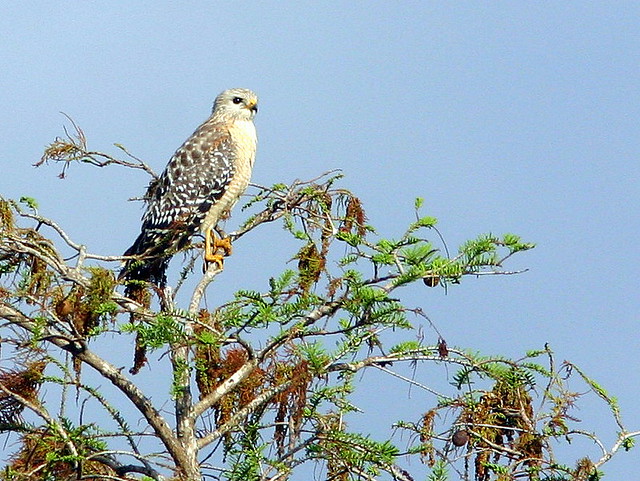
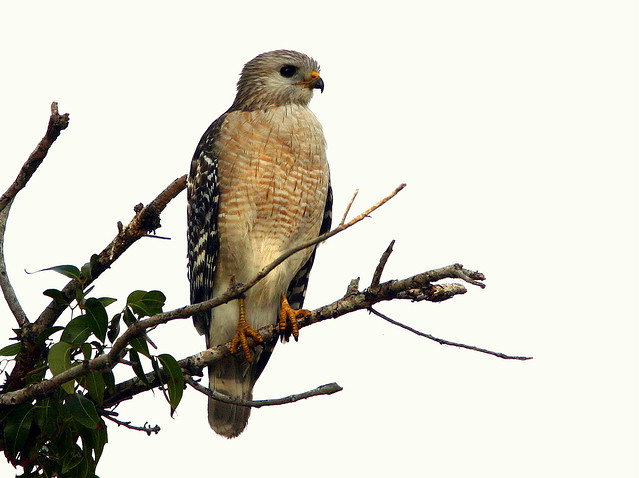
Immature Red-shouldered hawks also vary somewhat in the intensity of their streaked plumage, which they retain for about 18 months:
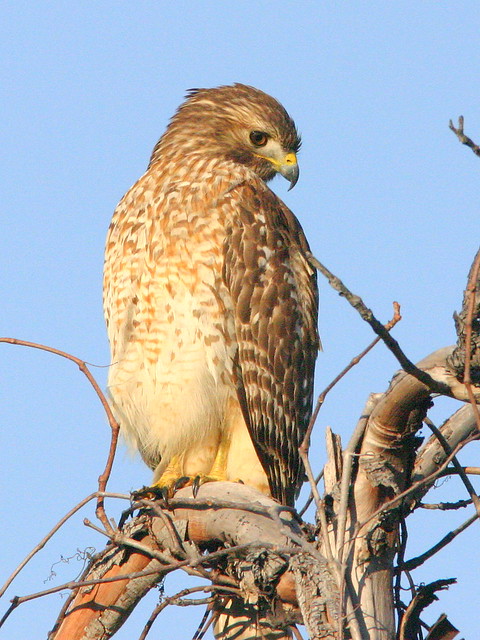
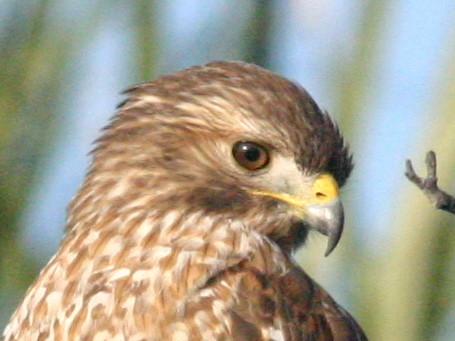
The red on the adults' shoulders shows up best in flight:
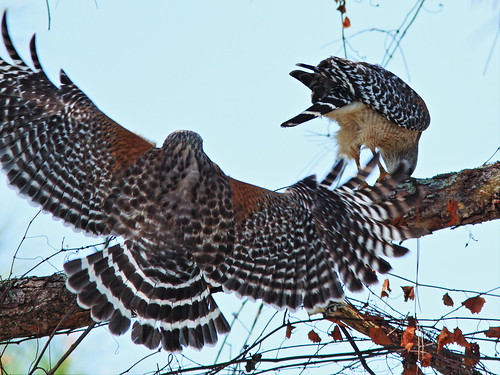
This juvenile Red-shouldered hawk exhibits a more useful identifying mark. The outer primaries are white at their base, creating a light band or "window" near its wingtips:
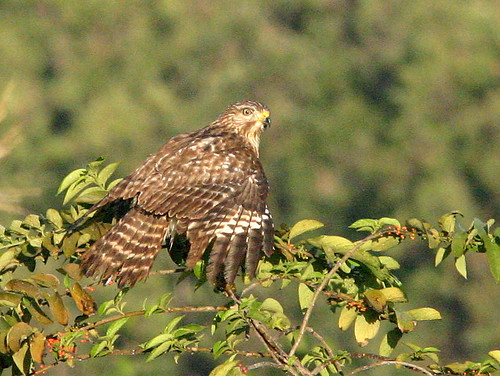
I usually hear and see one or more of this species on our morning walks in the local wetlands. This is a handsome adult bird:
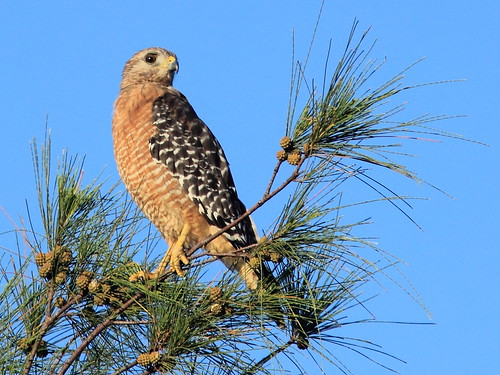
They prefer wetland habitats, and their diet varies by location. Amphibians, reptiles and invertebrates comprise about three-quarters of their prey in southern states, but studies in Quebec, Massachusetts, Wisconsin and Maryland have revealed a predominance of mammals. They also capture birds but are usually unsuccessful in such attempts.
One immature Red-shouldered Hawk currently favors an area along the entrance to our birding patch. It roosts in the tall Royal Palms along the sides of the road. Here it perches on a clump of the palm's fruit:
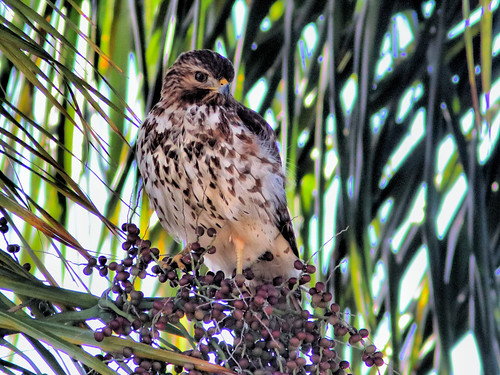


 = = = = = = = = = = = = = = =
= = = = = = = = = = = = = = =
Linking to Misty's CAMERA CRITTERS,
Linking to Eileen's SATURDAY'S CRITTERS,
Linking to GOOD FENCES by Tex (Theresa).
Linking to SKYWATCH FRIDAY by Yogi, Sylvia and Sandy
Linking to WEEKEND REFLECTIONS by James
Linking to BirdD'Pot by Anni
Linking to Wild Bird Wednesday by Stewart
Linking to Today's Flowers Friday by Denise
Linking to Wordless Wednesday (on Tuesday) by NC Sue
________________________________________________
Please visit the links to all these memes to see some excellent photos on display
________________________________________________
This past week we suddenly and unexpectedly traveled to southern Arizona.
Saguaro Cactus in the desert outside Tucson:
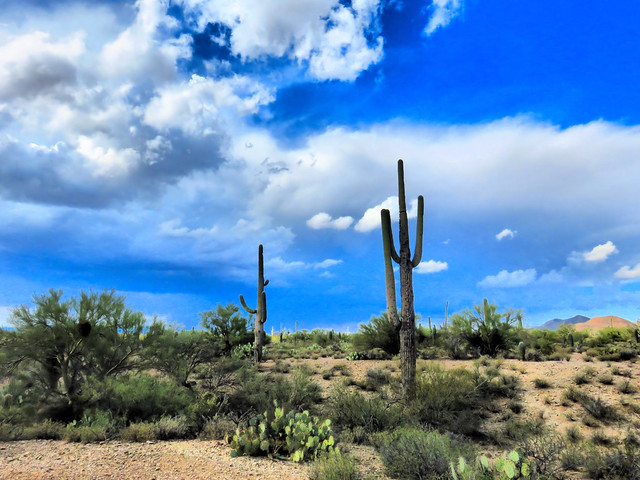 Just before our planned return to Florida from our second home in Illinois we learned that MaryLou's brother Jack, who lived in Tucson, Arizona was terminally ill and had entered hospice care. We arrived in Florida on Sunday and on Tuesday morning, hoping to visit him before the end, flew to Arizona. It was dark when we arrived and drove directly to see him. He was in a nearly comatose state and we worried he would not make it through the night.
Just before our planned return to Florida from our second home in Illinois we learned that MaryLou's brother Jack, who lived in Tucson, Arizona was terminally ill and had entered hospice care. We arrived in Florida on Sunday and on Tuesday morning, hoping to visit him before the end, flew to Arizona. It was dark when we arrived and drove directly to see him. He was in a nearly comatose state and we worried he would not make it through the night.
We stayed in the Air Force Inn at Davis-Monthan Air Force Base. The next morning (Wednesday) we visited him again at 9:00 AM. We were gratified to find him to be quite aware of his surroundings. On the way to the hospice facility we stopped by the Sweetwater Wetlands, quite nearby.

We got there before 7:30 AM and briefly joined a scheduled walk conducted by the Tucson Audubon Society:
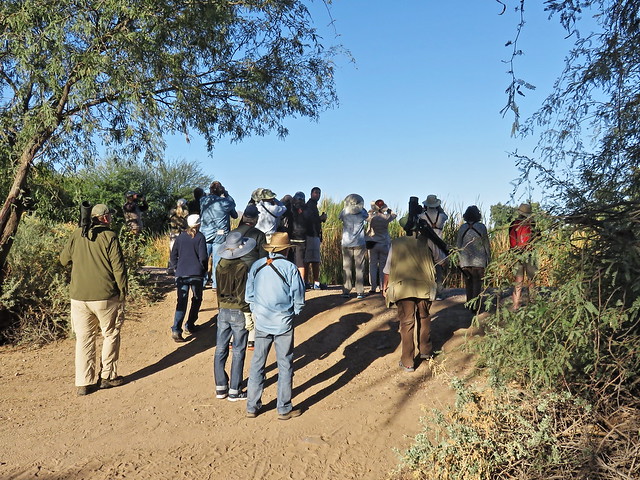
We only ventured a few hundred yards into the preserve but were rewarded with excellent sightings of a Cooper's Hawk...
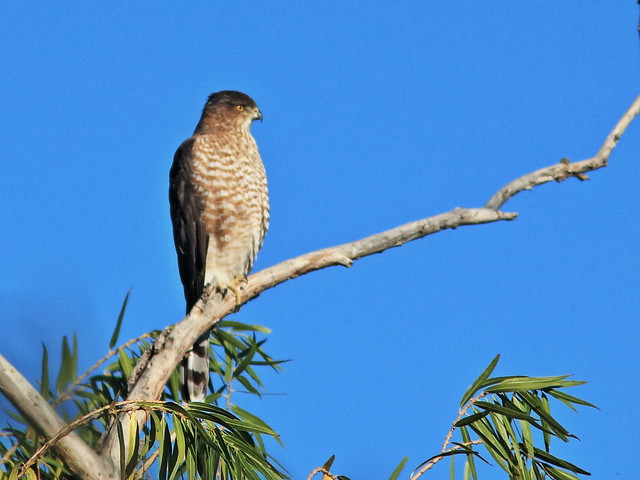
...Anna's Hummingbirds:
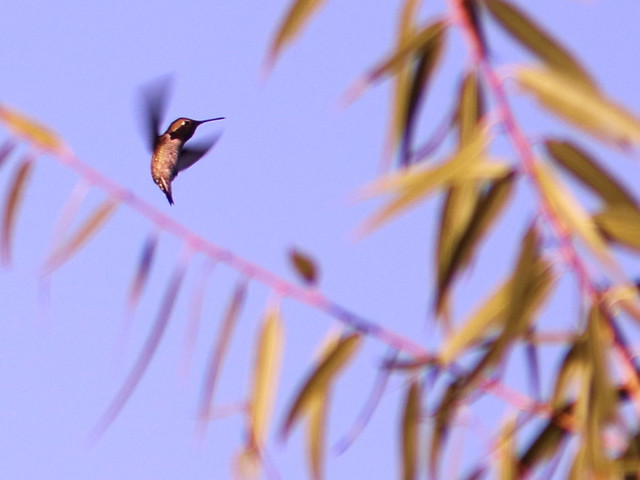

...and a flock of Yellow-headed Blackbirds:
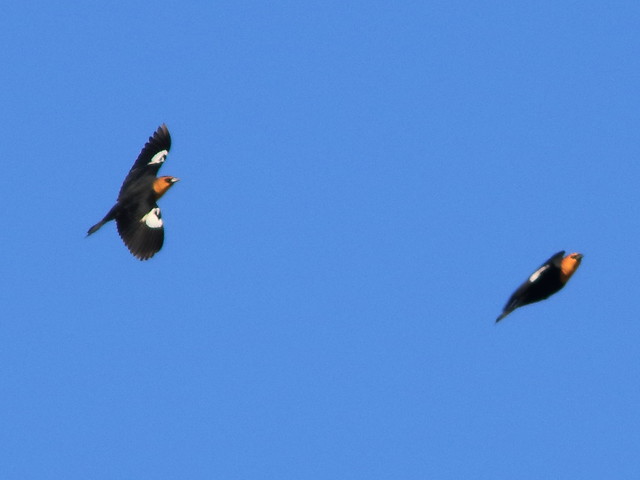
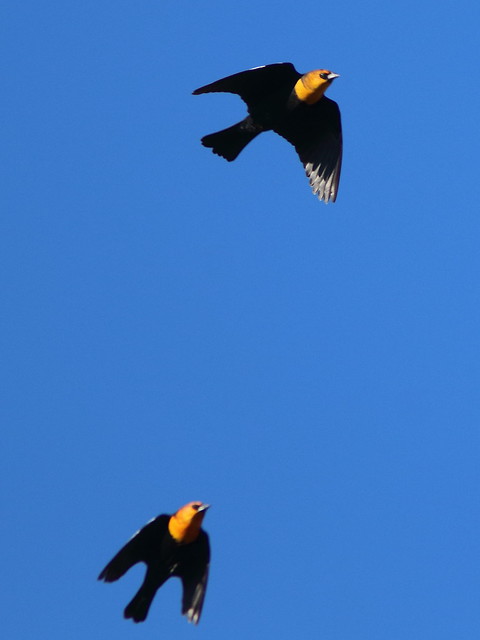
A Red-tailed Hawk alighted atop a power pole along the perimeter road:

This Desert Cottontail ventured across the path. Its long ears help dissipate body heat:
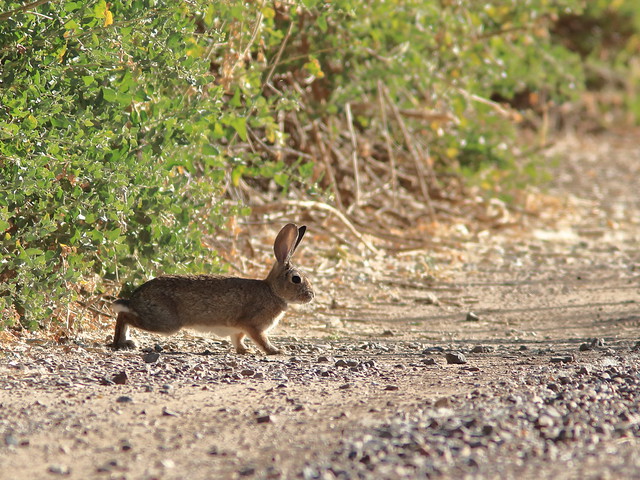
A highlight was this Red-naped Sapsucker, which I had seen when we lived in New Mexico, but it was my "first photographed" of this species:
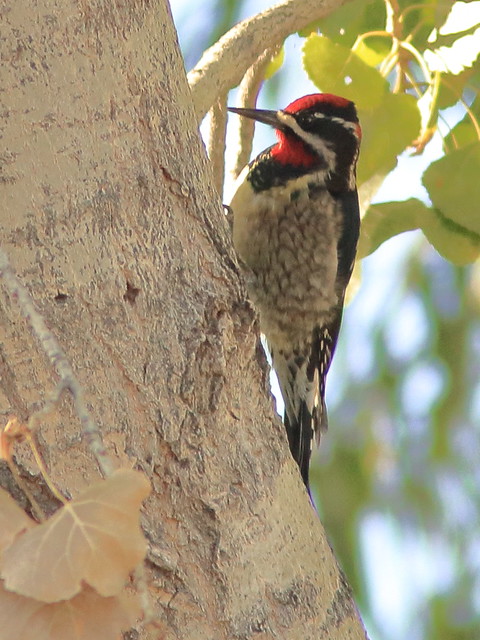
We had to hurry off but planned to make another visit to Sweetwater early the next day. We were surprised how much better my Brother-in Law appeared to be, and we stayed with him all morning and into mid-afternoon.
Jack's breathing was labored and his speech indistinct, but we conversed about current events in politics and particularly, sports. Jack is an attorney and had served as counsel for the Chicago White Sox baseball team. While he considered the Chicago Cubs to be his "number two team," he was avidly interested in seeing the Cubs in the final tie-breaking World Series championship game that very night (which they won).
Back at our quarters the next morning we were up very early because of jet lag due to the three-hours difference in time. We received a call from Jack's caregivers advising us that he had passed away quietly some time between 4 and 5:15 AM. Sad as this was, we were so grateful that we had one last chance to be with him-- much better than just coming out for a funeral.
We drove back to Sweetwater Wetlands and had time to be alone with nature. Although it was not nearly as "birdy" as it had been the previous morning, I captured photos of another "life bird photographed," the diminutive and reclusive Verdin:
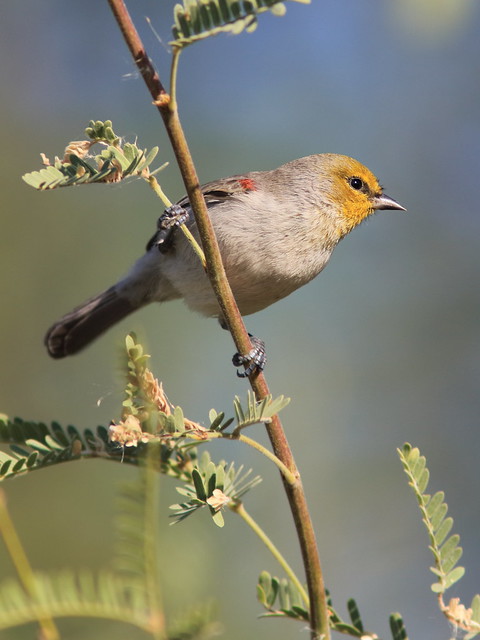
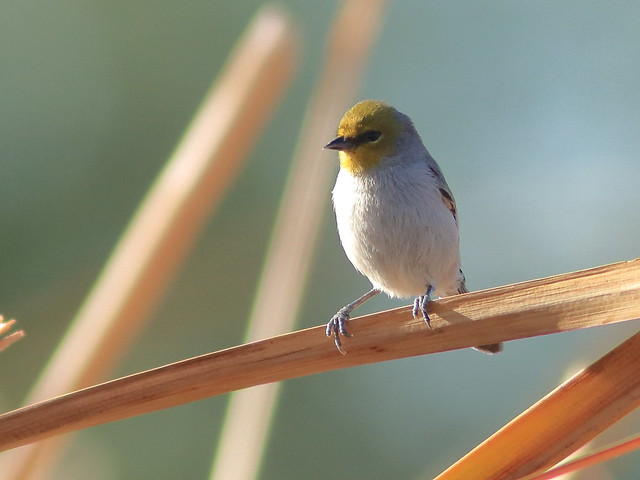
I am fondest of my first Verdin photo. While not a "bird guide" picture, it captures its arid environment and the bird's relative size:
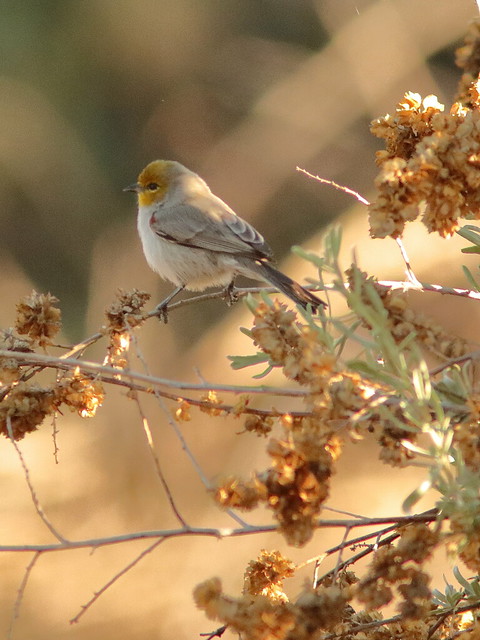
That afternoon, hot and tired, we briefly visited the Arizona-Sonora Desert Museum southwest of town. There were many visitors but few birds. Cactus Wrens were inviting subjects:
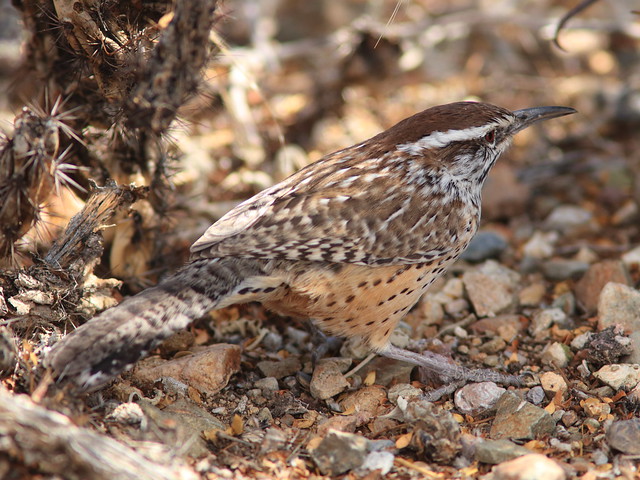
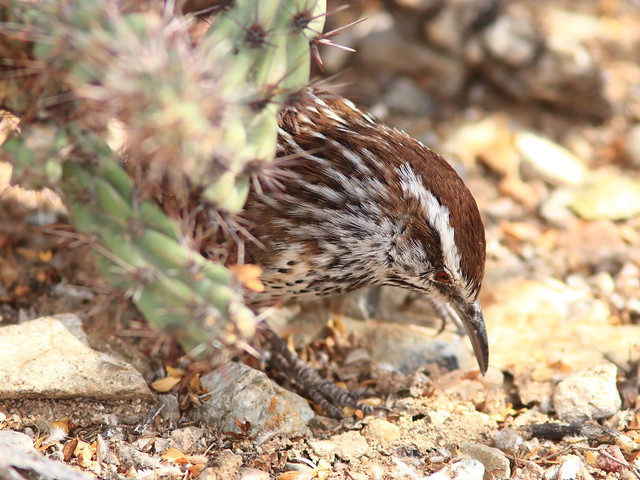
Butterflies were plentiful, among them a Clouded Sulphur...

...and a Common Checkered-Skipper:

Storms threatened as we departed the Museum:
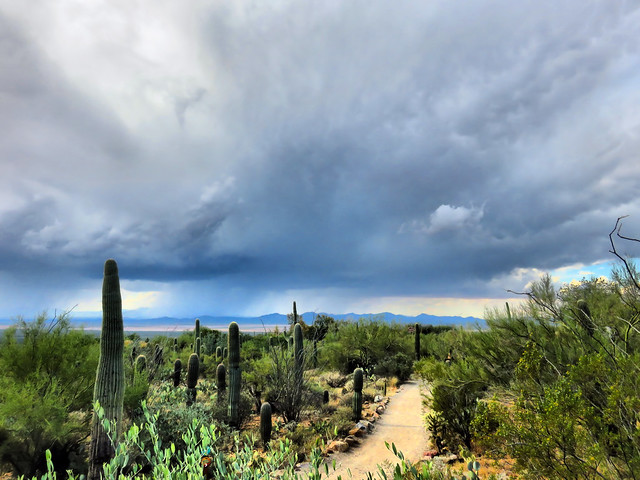
There was heavy rain Thursday night, but skies were clear for our early morning departure on Friday. We had to lead a South Florida Audubon bird walk the next morning. On Sunday the weather was cool and clear, perfect for grocery shopping to replenish the larders after being away from home for six weeks. Monday provided a cloudy dawn over the local wetlands:
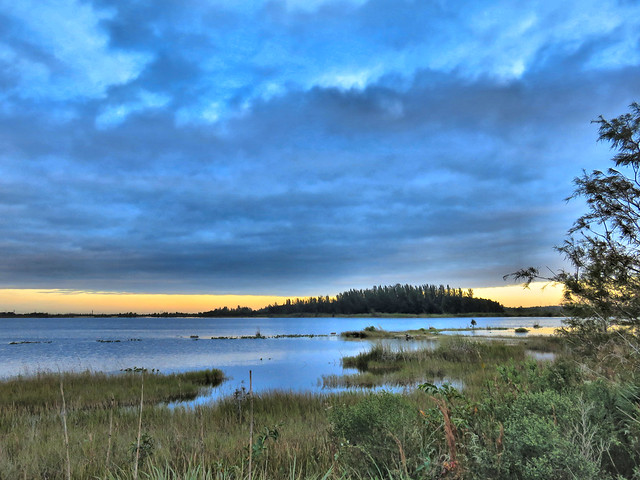
Great Egret reflection:
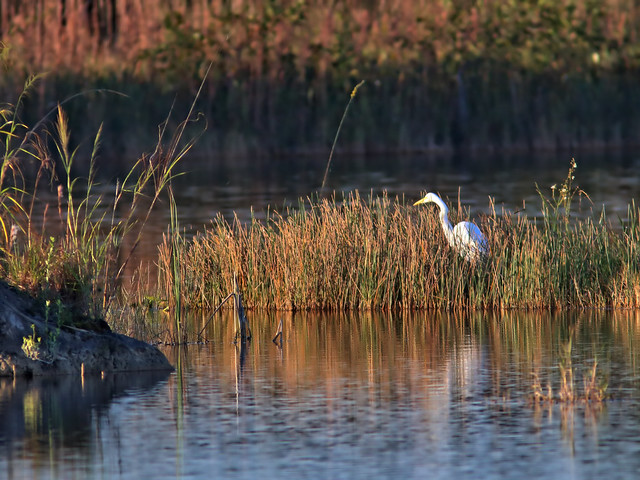
A fence along "The Road to Nowhere" at the north end of our birding patch:
 = = = = = = = = = = = = = = =
= = = = = = = = = = = = = = =
Linking to Misty's CAMERA CRITTERS,
Linking to Eileen's SATURDAY'S CRITTERS,
Linking to GOOD FENCES by Tex (Theresa).
Linking to SKYWATCH FRIDAY by Yogi, Sylvia and Sandy
Linking to WEEKEND REFLECTIONS by James
Linking to BirdD'Pot by Anni
Linking to Wild Bird Wednesday by Stewart
Linking to Today's Flowers Friday by Denise
Linking to Wordless Wednesday (on Tuesday) by NC Sue
________________________________________________
Please visit the links to all these memes to see some excellent photos on display
________________________________________________























































